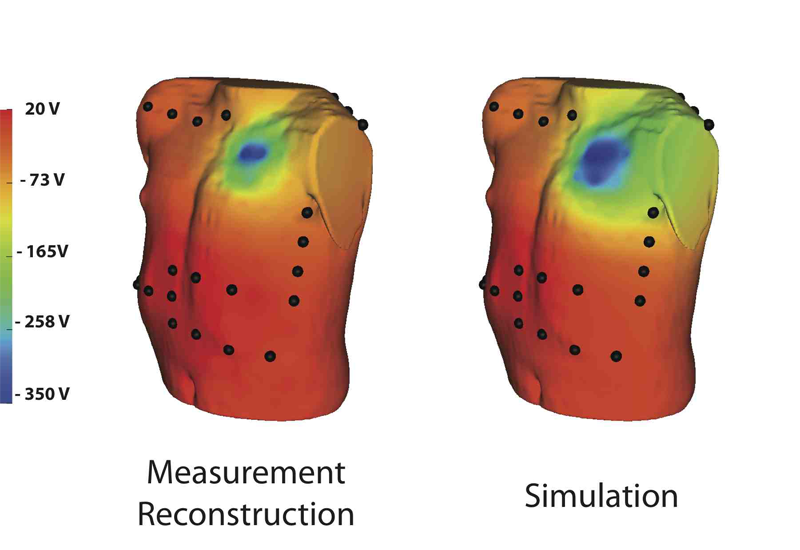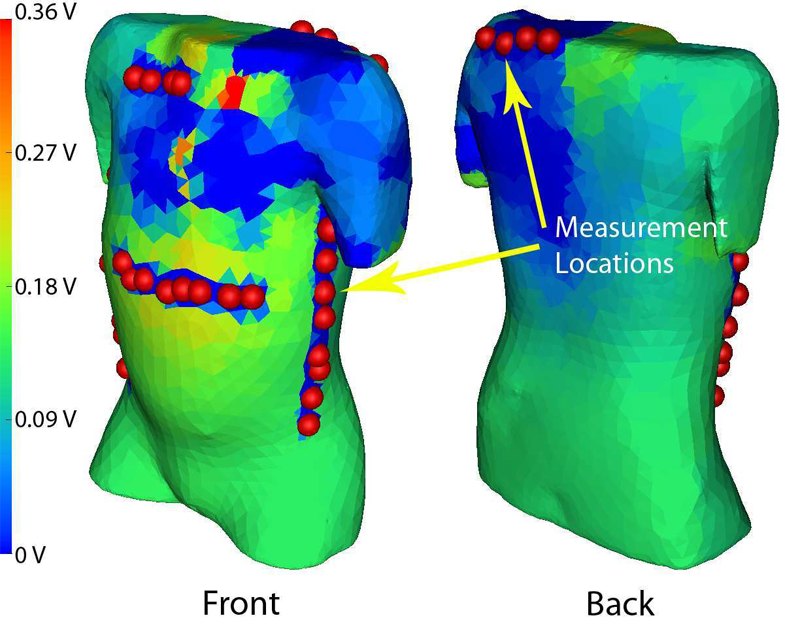2011
J.D. Tate, J.G. Stinstra, T. Pilcher, A. Poursaid, E. Saarel, R.S. MacLeod.
“Measuring Defibrillator Surface Potentials for Simulation Verification,” In Proceedings of the IEEE Engineering in Medicine and Biology Society EMBS 33rd Annual International Conference, pp. 239 - 242. 2011.
ISSN: 1557-170X
DOI: 10.1109/IEMBS.2011.6090045
PubMed ID: 22254294

Though implantable cardioverter defibrillators (ICDs) are increasing in use in both adults and children, little progress has been devoted to optimizing device and electrode placement. To facilitate effective ICD placement, especially in pediatric cases, we have developed a predictive model that evaluates the efficacy of a delivered shock. We have also developed an experimental validation approach based on measurements from clinical cases. The approach involves obtaining body surface potential maps of ICD discharges during implantation surgery using a limited lead selection and body surface estimation algorithm. Comparison of the simulated and measured potentials yielded very similar patterns and a typical correlation greater than 0.93, suggesting that the predictive simulation generates realistic potential values. This validation approach provides confidence in application of the simulation pipeline and offers areas to focus future improvements.
Keywords: Electric potential, Electric shock, Electrodes;Estimation, Lead;Surface reconstruction, Torso, Algorithms, Body Surface Potential Mapping, Computer Simulation, Defibrillators, Implantable, Humans, Models, Cardiovascular, Therapy, Computer-Assisted
J.D. Tate, J.G. Stinstra, T.A. Pilcher, R.S. MacLeod.
“Measurement of Defibrillator Surface Potentials for Simulation Verification,” In Computing in Cardiology, In 2011 Annual International Conference of the IEEE Engineering in Medicine and Biology Society, IEEE, pp. 853--856. Aug, 2011.
DOI: 10.1109/iembs.2011.6090045
2010
T.A. Pilcher, J.D. Tate, J.G. Stinstra, E.V. Saarel, M.D. Puchalski, and R.S. MacLeod.
“Partially extracted defibrillator coils and pacing leads alter defibrillation thresholds,” In Proceedings of the 15th International Academy of Cardiology World Congress of Cardiology, 2010.
J.D. Tate, J.G. Stinstra, T.A. Pilcher, R.S. MacLeod.
“Implantable Cardioverter Defibrillator Predictive Simulation Validation,” In Computing in Cardiology, pp. 853-–856. September, 2010.
Despite the growing use of implantable cardioverter defibrillators (ICDs) in adults and children, there has been little progress in optimizing device and electrode placement. To facilitate effective placement of ICDs, especially in unique cases of children with congenital heart defects, we have developed a predictive model that evaluates the efficacy of a delivered shock. Most recently, we have also developed and carried out an experimental validation approach based on measurements from clinical cases. We have developed a method to obtain body surface potential maps of ICD discharges during implantation surgery and compared these measured potentials with simulated surface potentials to determine simulation accuracy.
Each study began with an full torso MRI or CT scan of the subject, from which we created patient specific geometric models. Using a customized limited leadset applied to the anterior surface of the torso away from the sterile field, we recorded body surface potentials during ICD testing. Subsequent X-ray images documented the actual location of ICD and electrodes for placement of the device in the geometric model. We then computed the defibrillation field, including body surface potentials, and compared them to the measured values.
Comparison of the simulated and measured potentials yielded very similar patterns and a typical correlation between 0.8 and 0.9 and a percentage error between 0.2 and 0.35. The high correlation of the potential maps suggest that the predictive simulation generates realistic potential values. Ongoing sensi- tivity studies will determine the robustness of the results and pave the way for use of this approach for predictive computational optimization studies before device implantation.
2009
J.D. Tate, J.G. Stinstra, T. Pilcher, and R.S. MacLeod.
“Measuring Implantable Cardioverter Defibrillators (ICDs) During Implantation Surgery: Verification of a Simulation,” In Computers in Cardiology, pp. 473--476. 2009.
ISSN: 0276-6547
